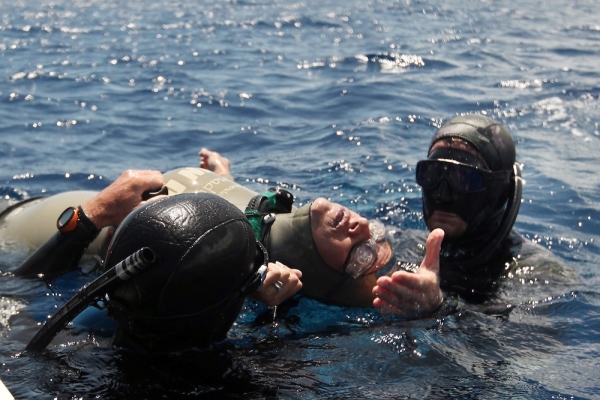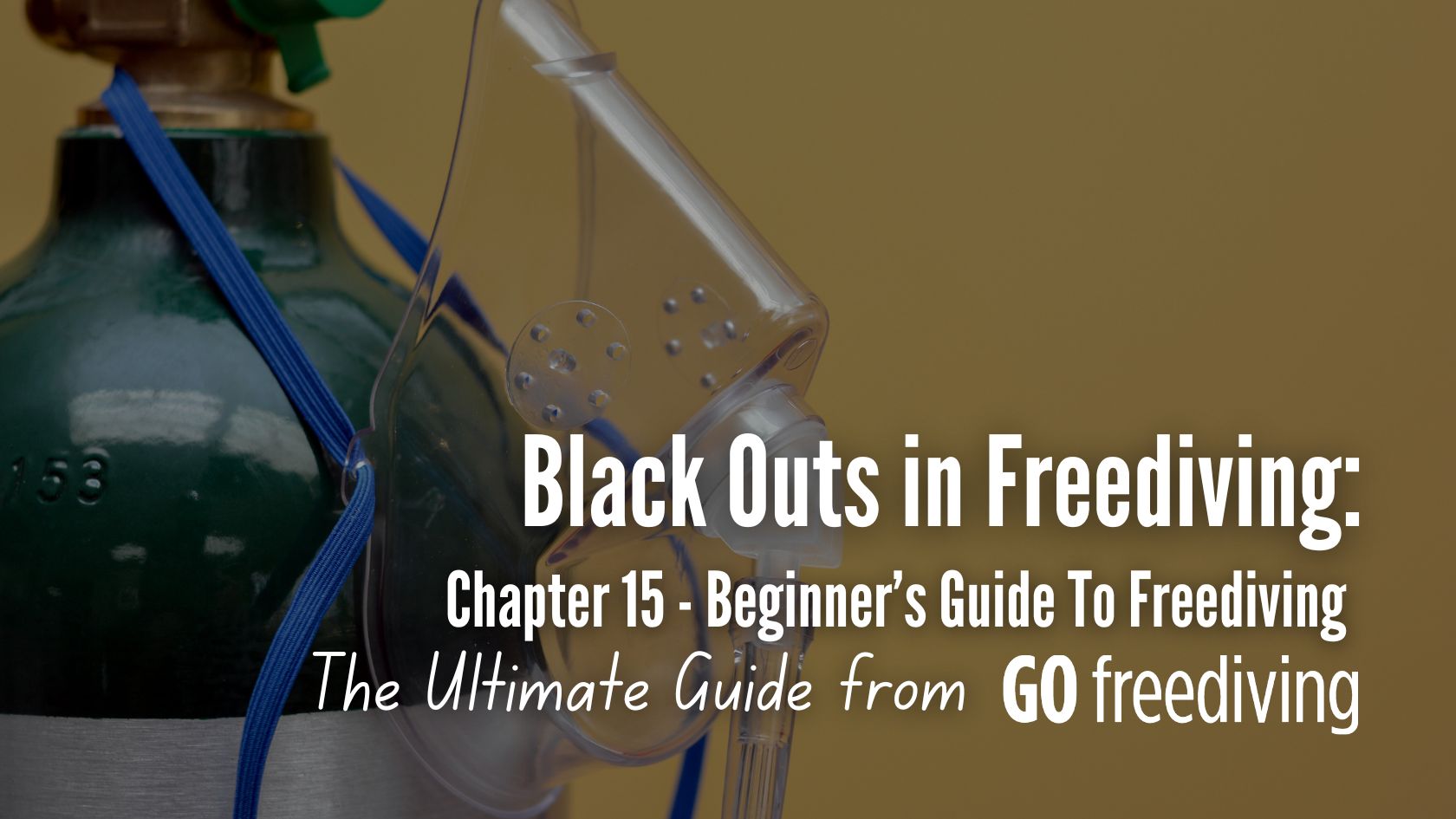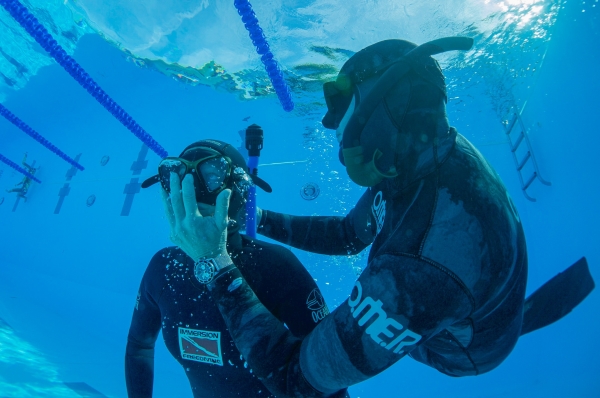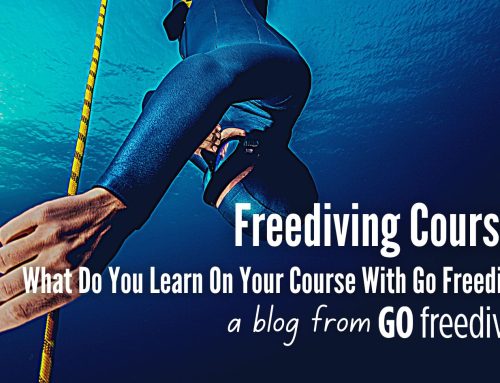Welcome to Part Fifteen of The Beginner’s Guide to Freediving, the best place to start your freediving journey. If you’re planning to start freediving, this chapter is a must-read for everyone. It focuses on black outs in freediving – explaining what they are, warning signs and symptoms, how to deal with one in your buddy and how to avoid them taking place at all.
Avoiding Black Outs and Hypoxic Fits in Freediving
With correct planning, common sense and safe diving practice, freediving is a low-risk and highly enjoyable sport that people of all ages and fitness levels can participate in. Freediving comes with inherent risks, though, primary among which are black outs and hypoxic fits.
Black outs in freediving – What are black outs and hypoxic fits?
Two of the biggest risks to freedivers are caused by low oxygen levels in the body due to a combination of a long breath hold and other factors. Low oxygen levels (or hypoxia to give its proper name) can result in hypoxic fits or black outs in freediving.
A black out is a complete loss of consciousness brought on by hypoxia and can happen underwater (such as a shallow water blackout), on the surface, and even after thirty seconds of poor recovery breathing. It can come on with no warning signs or symptoms and a freediver suffering one might not even be aware that it has taken place.
Some people worry that black outs in freediving will result directly in damage to the brain, but if the freediver is brought back to consciousness quickly then this will not be the case. A black out is actually your body’s way of protecting the brain and other vital organs by losing consciousness.

Carolina Schrappe lies unconscious at the surface after suffering a shallow-water blackout and was rescued by safety divers Garo Jack Hachigian and Ren Chapman. She was revived quickly and competing again the next day. Photo © Logan Mock-Bunting
Related to a black out is a hypoxic fit. This is a loss of motor control in the body, ranging from the subtle (a trembling of your hands, for example) to the severe, such as a full-body convulsion. In the past, freedivers have sometimes referred to it as a ‘samba’ because it can look like the dance of that name. A hypoxic fit always happens on the surface after a dive or breath hold and can be followed by a recovery or a full black out. Again, it can come on without warning and afterwards the sufferer is usually unaware that it has happened.
The risk factors causing hypoxic fits or blacks out in freediving can be many, and it is when multiple factors come into play that avoiding black outs in freediving is not possible. These are some of the main causes of black out and hypoxic fit:
- Hyperventilation – Any form of over-breathing, even two quick complete ventilations, will reduce levels of carbon dioxide in the blood, thus reducing your body’s urge to breathe. Without a strong urge to breathe, you can risk pushing your dive too far and blacking out due to low levels of oxygen. Hyperventilation also raises the heart rate, increases the speed at which the body burns oxygen, reduces blood flow to the brain, and causes oxygen to bond more strongly to haemoglobin, thus making it harder to access by the tissues that need it. Read our breathing article about correct breathing for freediving and adhere to it.
- Bad technique – Poor technique causes a freediver to waste energy and burn more oxygen. Imagine a freediver thrashing around on the surface as they perform a poor duck dive. By the time they have got their fins under the water they have already wasted significant amounts of their precious oxygen supply. Freediving successfully is about conservation of energy and making every movement as efficient as possible, maximising the limited oxygen available to the body.
- Stress – Connected to poor technique is stress. A stressed freediver will use oxygen more quickly than a relaxed one. Their heart rate will be higher and their movements will be tense, both of which use more oxygen.
- Poor recovery breaths – Many freedivers breathe poorly after a dive and this can lead to a black out or hypoxic fit. Often the diver focuses on a forceful exhale, removing most of the air from their lungs – air that still contains vital oxygen – rather than inhaling fresh air with only a passive exhalation. A diver can breathe incorrectly for 30 seconds and then still black out, so it is vital for the buddy to stay right by the diver until they are completely recovered.
- Talking and other unnecessary actions – when a freediver surfaces from a dive, they should not do anything other than hold onto something for support and focus on their recovery breaths. Often something happened on the dive which the diver wants to talk (or shout) about, but this can lead to a black out or hypoxic fit as the diver fails to do correct recovery breathing.
- Inexperience – A new freediver, particularly one who is physically fit with no equalisation issues, can often risk black out because they lack experience. They will know or dive with people who are reaching great depths and times, and believe that their own ability should match theirs without gaining sufficient experience to recognise warning signs or react appropriately when things do go wrong.
- Over ambition – Some freedivers are fearless and set their own bar too high. They dive deeper than they are capable of and for many reasons do not listen to the warning signs that their bodies are telling them – until it is too late.
Black outs in freediving – Prevention
There are many ways of avoiding black outs in freediving or to ensure that a black out or a hypoxic fit is an incredible unlikely scenario in your freediving career. Following these simple steps will help ensure safe and enjoyable diving:
- Don’t hyperventilate – I might have already mentioned this a few times…
- Take a freediving course and work with an instructor – Taking a course will enable an instructor to properly assess your breathing and technique, ensuring that you are breathing and moving as efficiently as possible. An instructor will also look at your kit setup and make sure that it is correct for you and the kind of freediving you are doing. They will also teach you the correct skills to be a good buddy, one who is able to rescue and revive a diver in trouble
- Increase depth and time gradually – Even if you are a natural freediver, it is important to progress gradually, becoming accustomed to each depth and time before moving on. It is far better to surface from a dive or breath hold feeling that it was easy and that you could have done so much more, than surface in a panic and feeling as if you were close to your limit. I sometimes hear new freedivers say that they want to experience a black out or hypoxic fit so that they know where their limits are. This is a complete fallacy. If you suffer a hypoxic fit or black out then you have not reached your limits, you have vastly exceeded them. In addition, your limits will change on a day-to-day basis. Just because you dived 30m yesterday or six months ago does not mean you can do the same today. Each dive session and dive should be approached on its own terms and if something does not feel right then you should pull back.
- Gain experience – Even though you control almost everything about your freediving, there will always be an occasion when something does not go according to plan. Maybe the line has been set to the wrong depth, you do not hear your depth alarm, your lanyard gets caught on the line, or your buddy fails to meet you where you had arranged. There are a myriad of things that may not go according to plan and gaining experience as a freediver and buddy will help you react calmly if something goes awry on a dive.
- Don’t dive cold, tired, dehydrated, hungry, unhappy or ill – We will look in more detail about some of these factors that affect your diving in the latter part of this article. Being cold and shivering will burn more oxygen and make your muscles and body tense. Being tired or unhappy will increase the chance you make a poor decision and cause you to be stressed. Dehydration thickens your blood, causing the heart to work harder and burn more oxygen, as well as affecting your mental capabilities. Low blood sugar increases the likelihood of black out. Being ill affects the whole functioning of your body, need we say more?
- Relax when you dive – Working with an instructor, diving with an experienced buddy that you trust and gaining experience will all help you feel confident when you freedive and enable you to relax, saving you oxygen.
- Take your snorkel out of your mouth when your freedive – Your snorkel is for breathing through on the surface and watching your buddy dive; you should never dive with it in your mouth. If you do, you will need to do a forceful exhale when you surface to clear it and this can be enough to cause you to black out. Then, if the jaw clamps shut around the snorkel with a laryngospasm, your buddy will not be able to remove it to perform rescue breaths. Additionally, when you do come round, your first breath in will be a snorkel-full of water, which is extremely dangerous for your lungs.
- Don’t look up on the ascent – There are two reasons that looking upwards increases the risk of a black out or hypoxic fit. Firstly, from a psychological perspective, looking up and seeing that the surface is further away than anticipated can cause a massive stress response, raising the heart rate and increasing the rate at which you are burning oxygen. In addition, this may cause you to speed up your finning when you should be slowing down and stopping. In dynamic swims this manifests itself as a race to the wall, increasing the amount of oxygen being burnt for no benefit. In addition, raising the head to look up can cause a decrease in blood flow to the brain, sending the wrong message to the baroreceptors in the carotid artery, resulting in either a raised the heart rate a black out as your body tries to conserve oxygen. It is your buddy’s job to make sure you are not going to hit anything on the ascent from a freedive.
- Slow down your ascent in the last few metres – Depending on the depth that you are diving, you should generally be positively buoyant for at least the last 10 metres of the dive and have stopped finning altogether with 3 to 5m to go. Because the greatest proportional pressure changes take place in the first 10m beneath the surface, this is where the greatest chance of black out occurs. As the volume of air in your lungs increases by 100% between 10m and the surface, proportionally more oxygen is being taken out of saturation in your blood, hence the term shallow water black out. By slowing down on the last part of your ascent and not rushing for the surface, you slow down the rate at which oxygen moves from the blood back to the lungs. By stopping finning you also conserve energy.
- Weight yourself correctly – As we covered in the article on weighting, it is imperative to be positively buoyant at the surface and, dependent on the diving you are doing, for the last third of the dive (or at least the last 12m if diving deep). By ensuring that you are positively buoyant you make it easier for your buddy to rescue you and keep you on the surface. It will also make the last part of your dive as easy and relaxed as possible, thus conserving oxygen when your reserves are at their lowest.
- Drop your weight belt if you are in difficulty – Safety is the primary reason that we wear quick release weight belts. A weight belt and weight does not cost very much, while your life is priceless. By ditching your weight belt if you get into trouble you increase your positive buoyancy, helping you get to the surface and stay there with less effort.
- Practice rescue techniques until they become second nature – By the time I had to rescue someone from a shallow water blackout, I had already performed hundreds of practice rescues from depth and acted instinctively. The rescue felt like just another drill even though I knew it was for real. You and your buddy need to feel confident that you can rescue each other and that if the worst came to the worst, your buddy would be there for you. As a buddy, never hesitate to rescue the diver if you think there is a problem. An annoyed diver is infinitely preferable to an unconscious one.
- Always dive with a competent buddy – If you suffer a shallow water black out with no buddy then it is game over for you and tragedy for your family and friends. If you black out and your buddy rescues you then it is a completely different outcome. Diving with a buddy has numerous benefits but the number one is their ability to save you after a black out or hypoxic fit. Your buddy should mirror you for at least the last 10m on a deep dive, the last 5m if you are diving shallower, and observe your whole dive from the surface if you are freediving recreationally in shallow water.
Black outs in freediving – Warning signs and symptoms
Avoiding black outs in freediving completely is not always possible. Hypoxic fits and black outs in freediving can occur with no warning signs at all. There are, though, some common symptoms to be look out for in other divers:
- Erratic or intermittent kick stroke (depth and dynamic disciplines)
- Speeding up (depth and dynamic disciplines)
- Pulling at the line as well as finning (depth and dynamic disciplines)
- Stopping moving (depth and dynamic disciplines)
- Moving (static)
- Failure to return taps (static)
- Letting air out
- Eyes unfocused, crossing or rolling back
- Anything abnormal
And even though you might fail to notice any of these things before suffering a black out or hypoxic fit yourself, these are some of the common symptoms you might feel if you’re in danger:
- Ringing in the ears
- Your field of vision starts to get smaller (‘tunnel vision’)
- Feeling of warmth, especially around the face
- Ecstatic feelings, and the dive suddenly feeling easier
- Confused and random thoughts
- A tingling feeling in the body
A hypoxic fit is a loss of motor control that can range from a subtle trembling to a full body fit. These are some of the most common signs in a diver that they are experiencing a hypoxic fit:
- Shaking, twitching and trembling
- Loss of posture, including the head jerking forwards or backwards
- Bodily spasm
- Facial distortion (‘gurning’)
- Eyes unfocused
- Confusion, reduced responsiveness or zero responsiveness
- Verbal distortion and incomprehensible mumbling
Black outs in freediving – How to deal with one
Dealing with black outs in freediving, whether in a pool or open water is almost identical. Dealing with a hypoxic fit is similar, although it can depend on the severity of the fit. The most important thing as a buddy is to be sufficiently practiced in rescue, so that if you need to help a diver you can do so quickly and effectively. Here we will look at how to rescue from depth, at the surface, and in a pool.
Black outs in freediving – Rescue from shallow water black out
As a buddy you should closely monitor the diver for the last part of their dive from no more than a hand’s grab away from them, eye-to-eye. If they suffer a black out, their rescue should proceed in the following stages:
Bring the diver to the surface with their airways closed and their mask (if they are wearing one) on their face.
There are two common holds for bringing a diver to the surface:
- You (the buddy) are behind the diver, your left arm under the diver’s left armpit, holding their jaw shut with the heel of your hand and pressing their mask to their face with your fingers. Your right hand can be placed on the back of the diver’s head, on their back, or be used to pull on the line, helping the ascent. This position means that you are in the correct position to help the diver at the surface, however it does means moving into this position once the diver has suffered a black out, and this may not be possible when time is of the essence.
- You (the buddy) reach forward with both hands, your left one to close the diver’s jaw and keep their mask on (as above) and your right hand to hold the back of the diver’s head. The advantage of this hold is that it is quick to execute and that it offers more room between you to use your fins to kick to the surface. The disadvantages are that you do not have a free hand to pull up on the line and at the surface you must move your left arm under their armpit.
The most important things is to get the diver to the surface s quickly as possible, so if necessary grab anything you can, be it their arm, fin, hair, whatever. Some buddies like to remove the diver’s weight but my personal view is that this is a distraction and should only be employed at depth if the diver is so heavily weighted that you cannot bring them to the surface easily. If this is the case then drop their weight and then, if you are still struggling, drop your own.
Keep the diver at the surface
This seems like an obvious thing, but I have seen many videos of rescues in old competitions, and had many students perform practice rescues on me where the diver is brought to the surface, their mask ripped off, and then promptly dropped under the water again. When you succeed in getting the diver to the surface, do not do anything else until you have them secured in your arms. This may involve ditching their weight and possibly yours if one or both of you are over-weighted.
Remove anything from the diver’s face
This includes a mask, nose clip, goggles, or anything else they may have on their face.
Blow, Tap, Talk
You want the diver to know that they are safe, their head is out of the water and that they can initiate the breathing response. We do this by blowing hard across the diver’s face, tapping them gently on the cheek or shoulder, and talking to them using their name, reassuring them that they are okay and encouraging them to breathe. Your hearing is the last thing to go when you black out and the first thing to return. The power of a person hearing their name should never be underestimated. The face contains baroreceptors which are sensitive to temperature and pressure; blowing across it helps activate these and tells the body that is can now safely start breathing.
If there’s no response after 15 seconds, give two strong mouth-to-nose rescue breaths
The diver may have suffered a laryngospasm, which means that rescue breaths to the mouth are impossible as the jaw has clamped shut. It is also easier to make a seal around the nose.
If the diver does not recover, tow them to a hard surface and begin CPR
A freediver who has experienced a black out will normally come round within 15 seconds. If they have not recovered after a minute, you must get them out of the water and onto a hard surface so you can begin chest compressions combined with rescue breaths until paramedics arrive. If you are far from shore, you must tow them. Whatever tow-hold you use, keep their airways out of the water. You can also do two rescue breaths for every eight fin kicks.
Black outs in freediving – Rescue from dynamic black out
The procedure for a black out rescue from the bottom of a pool is the same as the above. As a buddy you will always be behind the diver (unless they black out at the surface) and so will be in the ideal position to pick them up off the bottom of the pool with your left hand under their left armpit and your left hand on their chin and mask.
Black outs in freediving – Rescue from static black out
As a static buddy, if the diver blacks out face-down in a shallow pool then it is easier to turn them over, hold them securely and rescue them as above.
Black outs in freediving – Rescue from black out at the surface (open water or pool)
If a diver blacks out at the surface they may have already removed their facial equipment. If this is the case, you may have to catch their head if they fall face forward into the water. Once you have established a secure hold on them, the procedure is the same as above: Hold them securely out of the water, remove any facial equipment, BTT (blow, tap, talk), perform mouth-to-nose rescue breaths if they do not respond, then remove the diver from the water and perform CPR if they do not respond within a minute.
Black outs in freediving – Rescue from hypoxic fit
A hypoxic fit can be very subtle, with the diver able to support themselves without any assistance, or it can be a whole body fit, whereby the diver has no control over their body. The important thing is to support the diver, remove any facial equipment and talk to them, reassuring them that everything is okay. Be prepared for the hypoxic fit to lead to a black out.
It is important to check the diver and yourself for any injuries after a hypoxic fit. A fit is more likely to happen in a swimming pool as the diver can see you or the end of the pool and is more likely to push their limits. If a very big and strong diver has a full body fit and you can’t hold them securely, they can easily head butt or hit the side of the pool or you.
A reliable warning sign that someone is coming to the end of their breath holding ability is when they surface from a dive or breath hold and their lips are very blue or purple. This is cyanosis, where the oxygen levels in the blood is so low that the blood is blue rather than red. As a buddy you should be in the face of the diver as they surface anyway, and it is good to look at their lips and see what color they are as they surface and how they change over the course of fifteen or so minutes of recovery breaths. This isn’t as reliable indicator if you are diving in cold water as your lips and theirs may already be blue.
It is worth pointing out that low levels of oxygen can cause aggression. If a diver has suffered a black out or a hypoxic fit then they can become very angry, either at themselves or other people who they blame for ruining their dive or pulling them up when they claim to be fine.
Black outs in freediving – The after effects
If a diver has suffered a black out or a hypoxic fit then they should not dive again for the rest of the day and, depending on the severity of the incident, possibly for at least a week. Every person is individual and affected in different ways by a hypoxic episode, and it is important to listen to your body and not rush back into the water as the chances of suffering further fits or black outs in freediving, increase if you have not fully recovered.
If a diver does have a black out or hypoxic fit, apart from removing them from the water, it is a useful safeguard to get them to breathe pure oxygen for at least ten minutes afterwards and also drink some water and eat some food if they feel they may have low blood sugar.
As previously mentioned, avoiding black outs in freediving is not always possible. A black out can be a traumatic event for a diver if they were not expecting it. It is usually even more shocking for the buddy, as they have to witness and deal with it whist the diver is blissfully unaware of what is happening. For people new to the sport, seeing black outs in freediving can be frightening and can easily put them off. That is why it is important to fully understand the many ways of avoiding black outs in freediving, so you are not in a situation where a black out takes place.
After any incident it is imperative to sit down and assess what were the causes. What went wrong in the lead up to and during the dive, and how you, your buddy and those around you can learn from the experience, therefore increasing the chances of avoiding black outs in freediving in the future. It is impossible to completely avoid the possibility of a black out or hypoxic fit, but freedivers who follow the rules above are extremely unlikely ever to suffer a hypoxic episode.
Written by Emma Farrell
The Beginner’s Guide to Freediving is written by Emma Farrell. She is one of the world’s leading freediving instructors and has been teaching freediving since 2003. She is the author of the book ‘One Breath, a Reflection on Freediving’, has written courses that are taught worldwide, taught gold medal winning Olympic and Paralympic athletes, and has appeared numerous times on television teaching everyone from Hugh Fearnley-Whittingstall to Ellie Simmonds how to freedive.
Learn to freedive with the author of The Beginner’s Guide to Freediving
Go Freediving is the longest established, most experienced and friendliest freediving course provider in the UK, led by world class freediving instructor trainer Emma Farrell, and her team of personally trained instructors. No other course provider has such a good instructor to student ratio, safety record and personal touch.
Whether you’re a beginner dipping your toes into the world of freediving, a seasoned pro looking to turn professional, or simply a freediver of any level who wants the best freediving holiday in the world, we’re here for you!
Learn more about Freediving
Read the previous chapter of The Beginner’s Guide to Freediving – ‘Finning Techniques for Freediving’ here now
Read the next chapter of The Beginner’s Guide to Freediving – ‘Dealing with Risks Associated with Freediving’ here now
Keep in touch with everything Freediving
Subscribe to our mailing list for weekly newsletters with exclusive articles, news, films, offers and more!








Leave A Comment